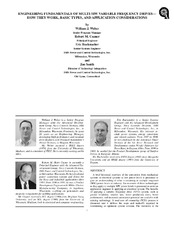| dc.contributor.other | Turbomachinery Symposium (31th : 2002) | |
| dc.creator | Weber, William J. | |
| dc.creator | Cuzner, Robert M. | |
| dc.creator | Ruckstadter, Eric J. | |
| dc.creator | Smith, Jim | |
| dc.date.accessioned | 2017-10-04T23:57:12Z | |
| dc.date.available | 2017-10-04T23:57:12Z | |
| dc.date.issued | 2002 | |
| dc.identifier.uri | https://hdl.handle.net/1969.1/163309 | |
| dc.description | Tutorial | en |
| dc.description | pg. 177-194 | en |
| dc.description.abstract | A brief historical overview of the conversion from mechanical systems to electrical systems at low power levels is presented to gain an understanding of what is occurring at multiple megawatt (MW) power levels in industry. An overview of drive technologies as they apply to multiple MW power levels is presented to assist an application engineer in applying an electrical system. The benefits of applying a variable frequency drive (VFD) system, such as greater reliability, smaller size, lower production costs, better performance, and increased automation potential are available with existing technology. A total cost of ownership (TCO) process is discussed and it defines the steps and tradeoffs required in determining an optimum system solution. The transition in the multiple MW market from mechanical systems to VFD systems is in process, and the rate of transition will accelerate over the next 10 years as the enabling drive technologies continue to be developed. | en |
| dc.format.medium | Electronic | en |
| dc.format.mimetype | application/pdf | |
| dc.language.iso | en | |
| dc.publisher | Texas A&M University. Turbomachinery Laboratories | |
| dc.relation.ispartof | Proceedings of the 31st Turbomachinery Symposium | en |
| dc.subject.lcsh | Turbomachines | en |
| dc.title | Engineering Fundamentals Of Multi-MW Variable Frequency Drives - How They Work, Basic Types, And Application Considerations. | en |
| dc.type.genre | Presentation | en |
| dc.type.material | Text | en |
| dc.identifier.doi | https://doi.org/10.21423/R11D3V | |


